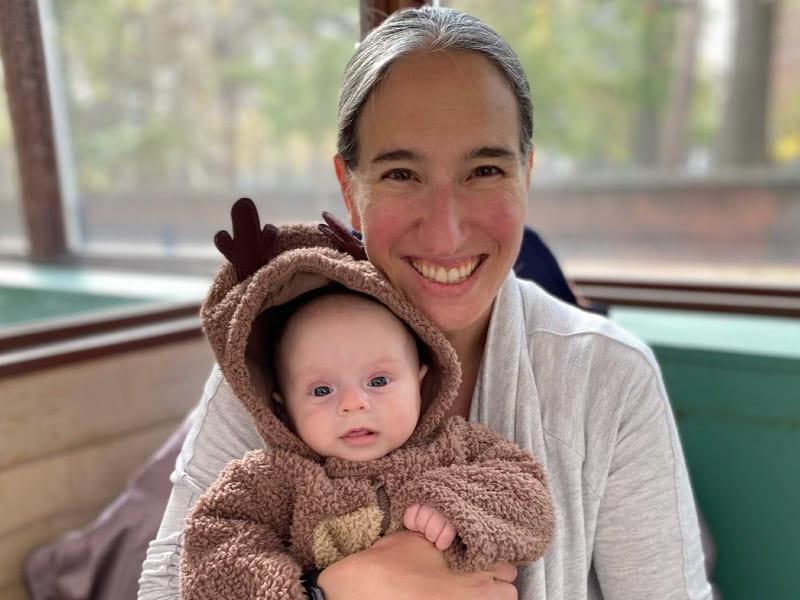High blood pressure isn't only a risk during pregnancy
By Joyce Tsai, American Heart Association News

After enduring a difficult pregnancy marred with severe bouts of nausea and vomiting, Christina Roberto recalls the overwhelming sense of relief she felt two years ago when she finally brought her newborn daughter, Charlotte, safely home from the hospital.
"It was a really stressful pregnancy," she said. "So there was this relief I felt getting home with Charlotte – and thinking everyone's safe and everyone's doing well."
That feeling wouldn't last for long. About a week into caring for her newborn, Roberto developed an unusual headache and stomach pains. With a home monitoring kit, she took her blood pressure and was shocked to discover it was alarmingly high at 180/110 mmHg.
She called a friend, an emergency medicine doctor, who advised her to go to the emergency room. There, Roberto learned that she had postpartum preeclampsia, a condition that causes high blood pressure and can cause other organs to not function normally. The diagnosis came as a shock because she'd never had high blood pressure, not even during her pregnancy.
Roberto is one of many thousands of women every year who develop high blood pressure postpartum, even though they never had a history of high blood pressure, also known as hypertension.
In fact, nearly 1 in 8 of such new mothers may develop hypertension in the year after delivery – with about a fifth of them developing it more than six weeks after giving birth, according to a study published last year in the American Heart Association journal Hypertension. Those at highest risk were age 35 or older, had a C-section or were a current or former smoker. But experts say it can strike anyone, even those without obvious risk factors.
Postpartum hypertension can be serious and life-threatening if left untreated. Severe cases have been associated with strokes, heart failure, seizures and kidney failure.
Hypertension and preeclampsia are most common in the first two weeks after giving birth, said Dr. Elizabeth Langen, an associate professor of obstetrics and gynecology and co-director of the cardio-obstetrics program at the University of Michigan in Ann Arbor.
That's why it's important, she said, that all new mothers know to look for the signs and symptoms of high blood pressure and preeclampsia during the weeks and months after childbirth. They can include a systolic (top number) blood pressure reading of 140 mmHg or higher or a diastolic (bottom number) reading of 90 mmHg or higher; blurry vision or seeing spots; a persistent headache; and shortness of breath. An over-the-counter blood pressure monitor allows women to check their blood pressure at home, as Roberto did.
If new mothers experience such symptoms, they should get evaluated by a health care professional who is aware they were recently pregnant, especially if they go to an urgent care or ER – or else it may increase the risk of more serious complications and even death, Langen said.
The American College of Obstetricians and Gynecologists advises new mothers to get a health checkup within three weeks of delivery, with additional visits scheduled as needed. That first checkup should be sooner – within three to 10 days after childbirth – for women who had high blood pressure during pregnancy.
For mothers who learn they have hypertension or preeclampsia postpartum, "it can be a very stressful and almost traumatic event, because they thought they weren't at risk and they didn't realize that something like this could happen after delivery," said Dr. Jennifer Lewey, a cardiologist at the hospital of the University of Pennsylvania and director of Penn Women's Cardiovascular Health Program.
For Roberto, it gave rise to another condition: postpartum anxiety.
"You're just very sad, because it's this fragile time where your hormones are raging," she said, "and you are thinking, 'Am I going to just stroke out and die? I need to live. I need to be here for my kid.'"
More programs around the country are remotely monitoring new mothers' blood pressure a couple of times a day, like at the University of Pennsylvania Health System, where Roberto enrolled after her diagnosis. But experts say more needs to be done to implement these programs nationwide, as well as educate all physicians about how to detect and treat these conditions.
Roberto, an associate professor of medical ethics and health policy at the University of Pennsylvania School of Medicine, said it worries her that many other women could be blindsided like she was if more isn't done to educate and build awareness for the problem.
"This wasn't something that anyone had talked to me about or warned me about," she said. "I was lucky to get the help I did, but I can't imagine that for the average mom giving birth, this is on her radar. But if it were, it could really be lifesaving."




